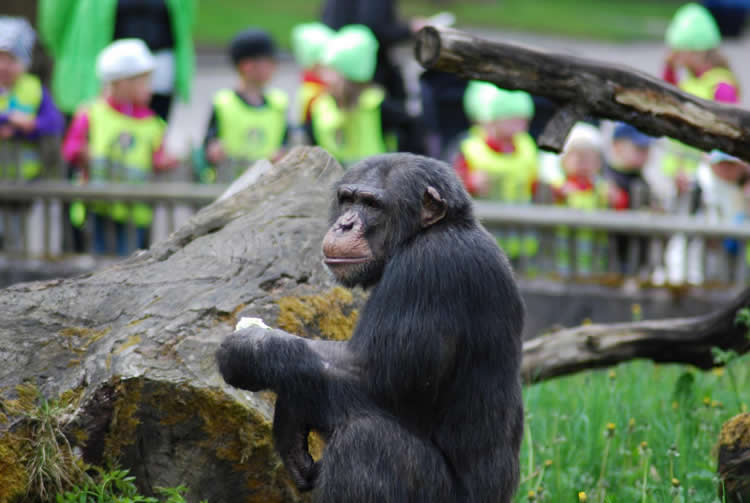Summary: Researchers reveal the social divide between chimps and humans isn’t as clear cut as once thought. Observing both animals and visitors at a zoo, researchers discovered about 10% of the actions produced by one species was an imitation of the other species.
Source: Lund University.
Copying the behaviour of others makes us effective learners and allow skills, knowledge and inventions to be passed on from one generation to the next. Imitation is therefore viewed as the key cognitive ability that enabled human culture to grow and create such things as language, technology, art and science. Decades of research has shown that apes, in spite of their proverbial aping abilities, are rather poor imitators, especially when compared to human children. The imitative superiority of children has been attributed to a higher social motivation to engage others in communication and the sharing of experiences. Current theories hold that apes are worse imitators because they lack this social and communicative side of imitation. The studies behind these theories, however, have focused on imitation in the area of learning solutions to physical problems.
A new study from Lund University, published in the journal Primates, has instead targeted the interactive side of imitation directly, and finds that the divide between humans and chimpanzees is less clear cut. By systematically observing the spontaneous interactions between zoo visitors and chimpanzees at Furuvik Zoo in Sweden, researchers found that both species imitated to a similar extent. About 10% of the actions produced by either species was an imitation of the other species’ actions.
“This took place in a typical zoo setting, where both chimpanzees and visitors tries to attract each other’s interest in various ways. We studied these interactions”, explains Dr. Tomas Persson, one of the researchers who conducted the study.
There was also significant overlap in the type of actions imitated by the two species. Both humans and chimpanzees imitated common actions, such as hand clapping and kissing or knocking on windows.
“The actions that were copied by both humans and chimpanzees were neither novel nor original and suggest that imitation was not at all about learning. The goal seemed to be purely social and communicative in nature”, says Persson.

The results also show that interactions that included imitation lasted longer than those without imitation. Imitation of simple gestures was thus a good way to initiate contact and keep the interaction going.
“Several times we observed prolonged interactions that took on a game-like back-and-forth character, which is reminiscent of how preverbal toddlers interact by way of imitating other’s play actions” says Dr. Gabriela-Alina Sauciuc, who conducted the study together with Persson.
The study is the first to systematically investigate spontaneous imitation between zoo chimpanzees and zoo visitors, and to highlight the social and communicative role that the imitation of familiar, routine actions may acquire during such interactions. The findings suggest that intentional imitation in ape evolution might have evolved for communicative and affiliative purposes, besides the more widely acknowledged learning function of imitation.
Source: Gabriela-Alina Sauciuc – Lund University
Image Source: NeuroscienceNews.com image is credited to Lund University.
Original Research: Full open access research for “Spontaneous cross-species imitation in interactions between chimpanzees and zoo visitors” by Tomas Persson, Gabriela-Alina Sauciuc, and Elainie Alenkær Madsen in Primates. Published online August 16 2017 doi:10.1007/s10329-017-0624-9
[cbtabs][cbtab title=”MLA”]Lund University “Both Chimps and Humans Spontaneously Imitate Each Other’s Actions.” NeuroscienceNews. NeuroscienceNews, 22 August 2017.
<https://neurosciencenews.com/chimp-human-mimic-actions-7343/>.[/cbtab][cbtab title=”APA”]Lund University (2017, August 22). Both Chimps and Humans Spontaneously Imitate Each Other’s Actions. NeuroscienceNew. Retrieved August 22, 2017 from https://neurosciencenews.com/chimp-human-mimic-actions-7343/[/cbtab][cbtab title=”Chicago”]Lund University “Both Chimps and Humans Spontaneously Imitate Each Other’s Actions.” https://neurosciencenews.com/chimp-human-mimic-actions-7343/ (accessed August 22, 2017).[/cbtab][/cbtabs]
Abstract
Spontaneous cross-species imitation in interactions between chimpanzees and zoo visitors
Imitation is a cornerstone of human development, serving both a cognitive function (e.g. in the acquisition and transmission of skills and knowledge) and a social–communicative function, whereby the imitation of familiar actions serves to maintain social interaction and promote prosociality. In nonhuman primates, this latter function is poorly understood, or even claimed to be absent. In this observational study, we documented interactions between chimpanzees and zoo visitors and found that the two species imitated each other at a similar rate, corresponding to almost 10% of all produced actions. Imitation appeared to accomplish a social–communicative function, as cross-species interactions that contained imitative actions lasted significantly longer than interactions without imitation. In both species, physical proximity promoted cross-species imitation. Overall, imitative precision was higher among visitors than among chimpanzees, but this difference vanished in proximity contexts, i.e. in the indoor environment. Four of five chimpanzees produced imitations; three of them exhibited comparable imitation rates, despite large individual differences in level of cross-species interactivity. We also found that chimpanzees evidenced imitation recognition, yet only when visitors imitated their actions (as opposed to postures). Imitation recognition was expressed by returned imitation in 36% of the cases, and all four imitating chimpanzees engaged in so-called imitative games. Previously regarded as unique to early human socialization, such games serve to maintain social engagement. The results presented here indicate that nonhuman apes exhibit spontaneous imitation that can accomplish a communicative function. The study raises a number of novel questions for imitation research and highlights the imitation of familiar behaviours as a relevant—yet thus far understudied—research topic.
“Spontaneous cross-species imitation in interactions between chimpanzees and zoo visitors” by Tomas Persson, Gabriela-Alina Sauciuc, and Elainie Alenkær Madsen in Primates. Published online August 16 2017 doi:10.1007/s10329-017-0624-9






